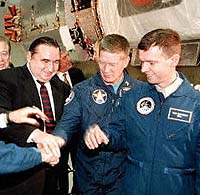ISS Won't See First Long-Term Crew Until October 30
Moscow (Interfax) July 26, 2000 - The first extended mission to the international space station will be launched "no earlier than October 30, as this was planned earlier," the head of the Russian Aerospace Agency said Wednesday.
Yuri Koptev was speaking at a news conference at Russian mission control after the successful docking of the Zvezda service module with the ISS at 4:44 a.m. Wednesday morning, Moscow time.
Officials at the news conference said this docking was an event that far surpasses in scale the docking of the Soyuz and Apollo twenty years earlier, as the Soviet and American ships were linked for only a few days and this was more of a political event than a technical achievement for the two Cold War rivals. Work on the ISS, meanwhile, will take at least 15 years and include at least 16 countries, Koptev said.
Mission control officials see the docking of the Zvezda with the Zarya-Unity tandem as a key turning point in the creation of the ISS, as now scientists, astronauts and "even journalists, if they find the money" can be sent to live on the station.
Officials complained that the government provides just 30% of the funding for this program. "Foreigners are surprised at how Russians manage to carry out such a large and expensive program without money," Koptev said.
After Wednesday morning's docking, Zvezda took over all of the control and orbit-correction functions for the ISS. Many of the onboard systems of the Zarya module that piloted the Zarya-Unity tandem were shut off, and the module, the station's first component, became a storage space for fuel and equipment.
In three weeks the first Progress cargo ship will automatically dock with the station and temporarily take over orbit control. Excess fuel will be pumped to the Zarya module along fuel lines laid through Zvezda.
 Zvezda Docks With ISS
Zvezda Docks With ISS
Korolev - July 26, 2000 - In a flawless docking, Russian ISS Mission Control in Korolev successfully oversaw the automated docking of the International Space Station with it newest module the Zvezda service module. Docking was at 8:45pm EDT July 25, (0045GMT July 26).
SPACE TRAVEL
|

File Photo: Anatoly Kiselev (L), Director of the Khrunichev Research and Production Space center shakes hands with the US-Russian joint space crew, Bill Shepherd (C) and Russian Yuriy Gidzenko (R) after a news conference in Moscow, 17 January, 1998. Photo by Uriy Kochetkov - Copyright AFP 2000 |
ISS P1 Trusss Arrives At KSC
Huntsville - July 26, 2000 - Another International Space Station (ISS) truss segment arrived today at KSC's Shuttle Landing Facility aboard the "Super Guppy" transport aircraft. The truss segment was manufactured by a division of the Boeing Company in Huntington Beach, Calif. and assembled in Huntsville, Ala.
This truss segment, called "P1," is a 46-by-15 foot structure weighing about 32,000 pounds when fully outfitted and ready for launch. The P1 truss will attach to the port side of the center truss, S0, and will be the third truss assembled to the ISS as part of a total 10-truss, girder-like structure that will ultimately extend the length of a football field. Scheduled for launch in the spring of 2002, astronauts will use the orbiter's robot arm to attach the P1 truss to the S0 truss. During later assembly flights, the astronauts will attach remaining truss segments to the port side of P1.
During processing at KSC, one radiator wing comprising three radiator assemblies will be installed on the truss structure. The P1 radiators dispose of thermal energy into space to maintain thermal conditioning for the ISS. The radiator assemblies are launched in a stowed position and will be deployed on orbit by a scissors-type mechanism.
Other items to be attached to the P1 truss include power distribution system modules, computers, a grapple fixture and a UHF antenna. In addition, the P1 truss provides rails on which Canada's Mobile Service System will move its 55-foot robotic arm down the length of the 300-foot truss structure.
The P1 truss was transported to the Operations and Checkout Building, which has been reconfigured from a Spacelab processing facility to accommodate ISS truss processing.
|
